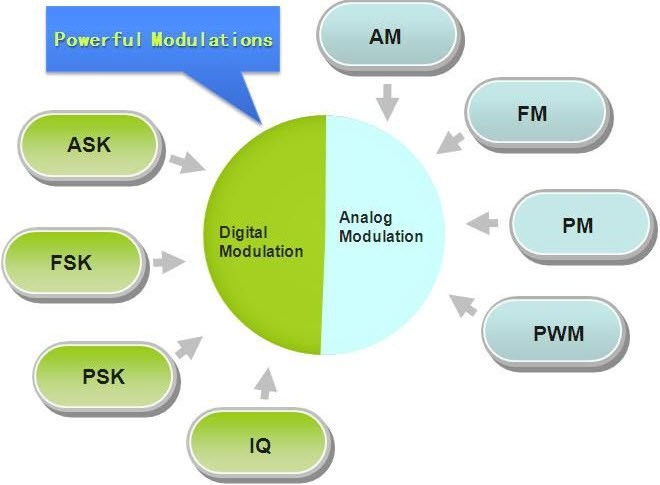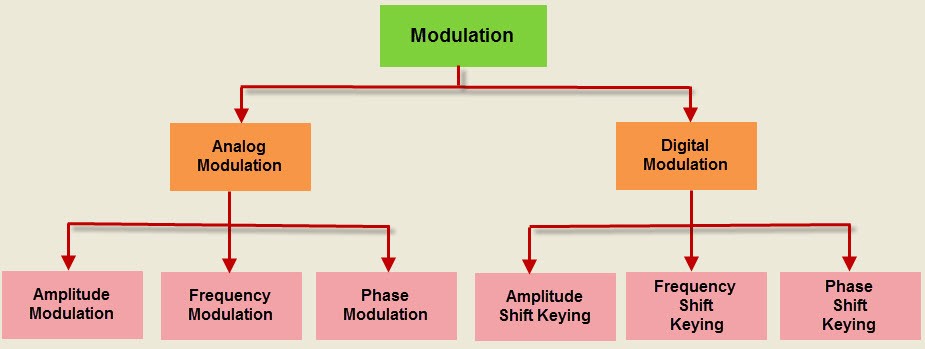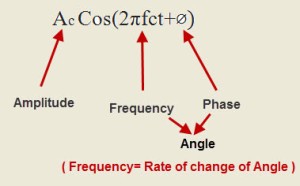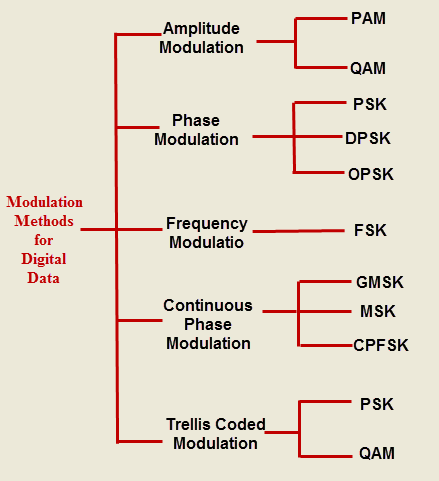
Types of Modulation
Communication is the basic attraction of mankind as it gives the knowledge of what is going on around us. In our daily life, we communicate with many people and use the entertainment media like television, radio, internet and newspaper to get ourselves involved. These entertainment media act as a source of communication. Electronic communication comprises TV, radio, internet, etc. When we want to transmit a signal from one location to another, we have to strengthen the signal. After undergoing strenghthening process the signal travels to a long distance. This is called as modulation, and this article gives an overview of the modulation and types of modulation techniques.
Communication is nothing but, the process of exchanging (two way communication) or passing (one way communication) information from one person to another. The basic electronic communication system consists of these components: transmitter, receiver and communication channel.

Communication System
A transmitter is a group of electronic circuits designed to convert the information into a signal for transmission over a given communication medium.
A receiver is a group of electronic circuits designed to convert the signal back to the original information.
The communication channel is the medium which is designed to transmit the electronic signal from one place to another.
What is Modulation?
Modulation is nothing but, a carrier signal that varies in accordance with the message signal. Modulation technique is used to change the signal characteristics. Basically, the modulation is of following two types:

Modulation Techniques
- Analog Modulation
- Digital Modulation
Please refer to this link to know more about Modulation MCQs
Analog Modulation
In analog modulation, analog signal (sinusoidal signal) is used as a carrier signal that modulates the message signal or data signal. The general function Sinusoidal wave’s is shown in the figure below, in which, three parameters can be altered to get modulation – they are amplitude, frequency and phase; so, the types of analog modulation are:

Analog Modulation
- Amplitude Modulation (AM)
- Frequency Modulation (FM)
- Phase Modulation (PM)
Amplitude Modulation
Amplitude modulation was developed in the beginning of the 20th century. It was the earliest modulation technique used to transmit voice by radio. This type of modulation technique is used in electronic communication. In this modulation, the amplitude of the carrier signal varies in accordance with the message signal, and other factors like phase and frequency remain constant.
The modulated signal is shown in the below figure, and its spectrum consists of the lower frequency band, upper frequency band and carrier frequency components. This type of modulation requires more power and greater bandwidth; filtering is very difficult. Amplitude modulation is used in computer modems, VHF aircraft radio, and in portable two-way radio
Frequency Modulation
In this type of modulation, the frequency of the carrier signal varies in accordance with the message signal, and other parameters like amplitude and phase remain constant. Frequency modulation is used in different applications like radar, radio and telemetry, seismic prospecting and monitoring newborns for seizures via EEG, etc.
This type of modulation is commonly used for broadcasting music and speech, magnetic tape recording systems, two way radio systems and video transmission systems. When noise occurs naturally in radio systems, frequency modulation with sufficient bandwidth provides an advantage in cancelling the noise.
Please refer to this link to know more about Frequency Modulation MCQs
Phase Modulation
In this type of modulation, the phase of the carrier signal varies in accordance with the message signal. When the phase of the signal is changed, then it affects the frequency. So, for this reason, this modulation is also comes under the frequency modulation.
Generally, phase modulation is used for transmitting waves. It is an essential part of many digital transmission coding schemes that underlie a wide range of technologies like GSM, WiFi, and satellite television. This type of modulation is used for signal generation in al synthesizers, such as the Yamaha DX7 to implement FM synthesis.

Types of Analog Modulation
Therefore, Analog modulation includes AM, FM and PM and these are more sensitive to noise. If noise enters into a system, it persists and gets carried up to the end receiver. So, this drawback can be overcome by the digital modulation technique.
Digital Modulation
For a better quality and efficient communication, digital modulation technique is employed. The main advantages of the digital modulation over analog modulation include available bandwidth , high noise immunity and permissible power. In digital modulation, a message signal is converted from analog to digital message, and then modulated by using a carrier wave.

Digital Modulation
The carrier wave is switched on and off to create pulses such that the signal is modulated. Similar to the analog, in this system, the type of the digital modulation is decided by the variation of the carrier wave parameters like amplitude, phase and frequency.
The most important digital modulation techniques are based on keying such as
Amplitude Shift Keying, Frequency Shift Keying, Phase Shift Keying, Differential Phase Shift Keying, Quadrature Phase Shift Keying, Minimum Shift Keying, Gaussian Minimum Shift Keying, Orthogonal Frequency Division Multiplexing, etc., as shown in the figure.
In an Amplitude shift keying, the amplitude of the carrier wave changes based on the message signal or on the base-band signal, which is in digital format. It is sensitive to noise and used for low-band requirements.
In frequency shift keying, the frequency of the carrier wave is varied for each symbol in the digital data. It needs larger bandwidths as shown in the figure. Similarly, the phase shift keying changes the phase of the carrier for each symbol and it is less sensitive to noise.

Types of Digital Modulation
Communication-Based Project Ideas
Communication based projects mainly covers a wide range of areas such as GSM, GPS, Bluetooth, RFID, DTMF, Mobile, Ethernet, RF, XBEE, Networking, Data Acquisition and Smart Card. The following is a list of communication based projects for engineering students:
- Cell Phone Based DTMF Controlled Garage Door Opening System
- Zigbee Technology Based Industrial Automation
- Display of Dialed Telephone Numbers on Seven Segment Displays
- Automatic Dialing to any Telephone Using I2C Protocol on Detecting Burglary
- DTMF Based Load Control System
- Cell Phone Controlled Robotic Vehicle
- GSM Based Energy Meter Reading with Load Control
- Railway Track Security System
- GSM Based Wireless Electronic Notice Board
- RFID Technology Based Device Control and Authentication system using PIC Microcontroller
- Theft Intimation of Vehicle Over SMS to Owner
- GSM Based Energy Meter Reading With Load Control Using PIC Microcontroller
- RF Controlled Robotic Vehicle With Laser Beam Arrangement
- Automatic Bus Location Announcement System using Microcontroller and GPS
- Pick N Place Robot With Soft Catching Gripper
- Fire Fighting Robotic Vehicle
- War Field Spying Robot with Night Vision Wireless Camera
- Wireless Power Transfer
- Speed Synchronization of Multiple Motors in Industries
- RF based Unique Office Communication System
- Touch Screen Based Home Automation System
- RFID Security Access Control System
- RFID Based Attendance System
- RFID Based Passport Details
- Device Control and Authentication using RFID
- Wireless Message Communication between Two Computers
- XBEE Based Remote Monitoring of 3 Parameters on Transformer / Generator Health
- XBEE Based Remote Monitoring of 3 Parameters on Transformer / Generator Health with Voice Announcement and Wireless PC Interface
- Remote AC Power Control by Android Application with LCD Display
- Advanced Embedded System Based Remote Robot using RF
- War Field Spying Robot with Night Vision Wireless Camera by Android Applications
- Remote Induction Motor Control by Android Application with 7 Segment Display
- Remote Operated Domestic Appliances Control by Android Application
- Remote Password Operated Load Control by Android Applications
- Density Based Auto Traffic Signal Control with Android Based Remote Override
- Four Quadrant Operation of DC Motor Remotely Controlled by Android Applications.
- Wireless Data Communication Project on Data Encryption and Decryption Using Zigbee
Please refer to this link to know more about 7 Segment Display MCQs.
These are the different types of modulation in communication system and communication projects. Therefore, the readers, can share their ideas, suggestions and comments in the comment section below.